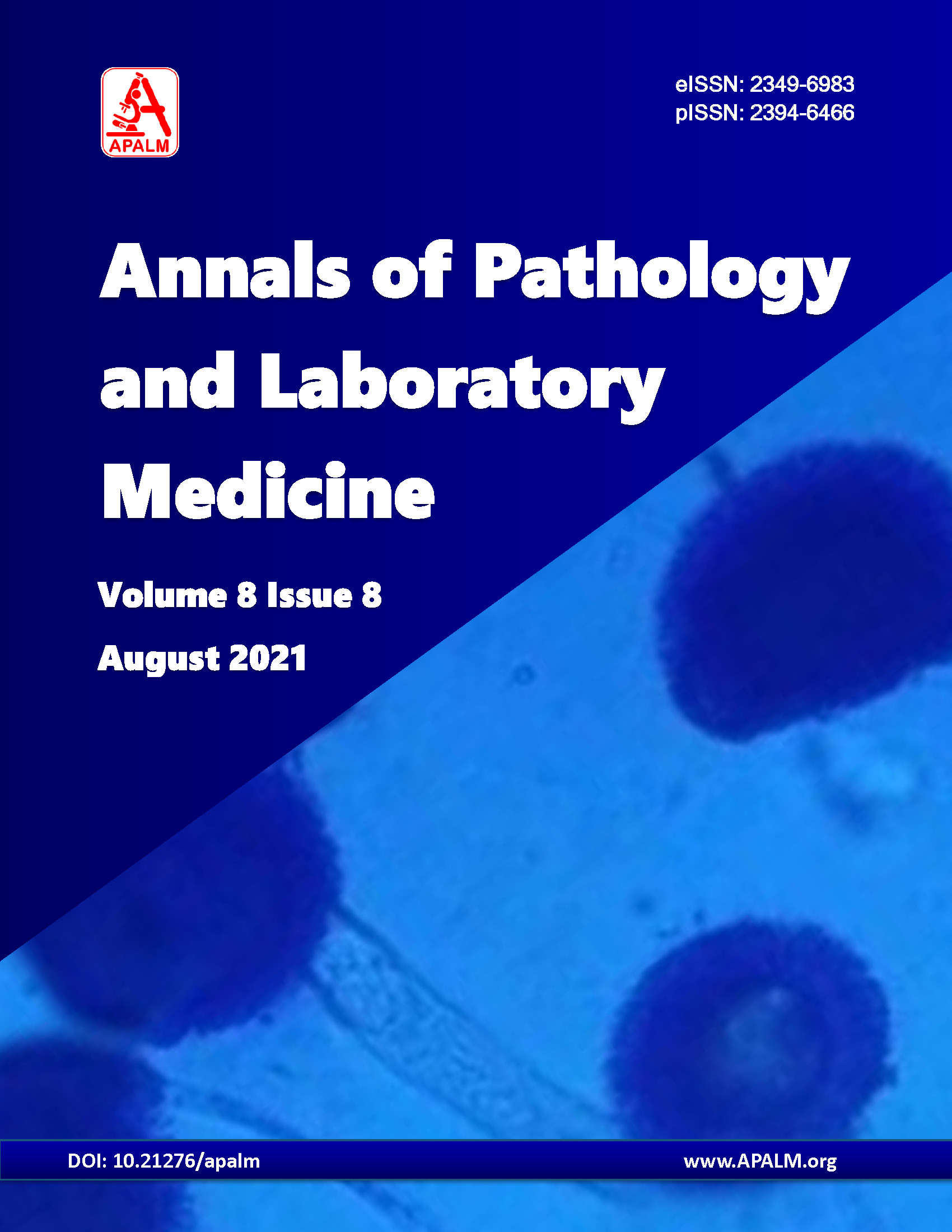A Study Depicting Histomorphology of Third Trimester Placenta in SARS-Cov-2 Positive Women
DOI:
https://doi.org/10.21276/apalm.3070Keywords:
SARS-Cov-2, Third trimester, Placenta, histomorphological changesAbstract
Background: This study aims to detect association of SARS-COV-2 infection in terms of histopathological changes in the third trimester placenta.
Methods: SARS COV 2 positive placenta cases received in Department of Pathology, Gandhi Medical College and Hamidia Hospital, Bhopal, Madhya Pradesh. 7 cases were sent for histopathological examination. Clinical details, history, details of relevant investigation like D-dimer, blood reports etc. was taken from the electronic medical records and requisition form received in the Department of Pathology. Histopathological findings were analyzed and recorded.
Result: This is a case series depicting various histopathological changes in term placenta of 7 SARS Corona Virus 2 (COV-2) positive women in the age group of 20 years to 35 years exhibiting symptoms ranging from mild to severe degree. The major histopathological finding noticed is under perfusion of placenta of maternal side in greater extent as compared to fetal side under perfusion followed by signs of inflammation of membranes viz chorionitis and chorioamnionitis. Hence, through the study, we want to highlight micro vasculopathy as one of the pathophysiological features of SARS Corona Virus 2 (COV-2) which might be leading to these histopathological findings and its correlation with elevated levels of D — Dimer.
Conclusion: Covid 19 positive women with third trimester of placenta do not express any specific histomorphological findings. Our study shows only signs of maternal and fetal vascular under perfusion with mild acute chorionitis which might have a relationship to a microvascular disease induced by SARS COVID 19 virus, yet this cannot be ruled out consistently proven several associated factors.
References
Petrilli CM, Jones SA, Yang J, Rajagopalan H, et al. Factors associated with hospital admission and critical illness among 5279 people with coronavirus disease 2019 in New York City: prospective cohort study. BMJ. 2020 May 22;369:m1966.
Mousavizadeh L, Ghasemi S. Genotype and phenotype of COVID-19: Their roles in pathogenesis [published online ahead of print, 2020 Mar 31]. J Microbiol Immunol Infect. 2020.
Xu, H., Zhong, L., Deng, J. et al. High expression of ACE2 receptor of 2019-nCoV on the epithelial cells of oral mucosa. Int J Oral Sci 12, 8 (2020).
Ho, D., Leong, J.W., Crew, R.C. et al. Maternal-placental-fetal biodistribution of multimodal polymeric nanoparticles in a pregnant rat model in mid and late gestation. Sci Rep 7, 2866 (2017).
Fenizia, C., Biasin, M., Cetin, I. et al. Analysis of SARS-CoV-2 vertical transmission during pregnancy. Nat Commun 11, 5128 (2020).
Egloff C, Vauloup-Fellous C, Picone O, Mandelbrot L, Roques P. Evidence and possible mechanisms of rare maternal-fetal transmission of SARS-CoV-2. J Clin Virol. 2020 Jul; 128:104447
Baergen RN, Heller DS. Placental Pathology in Covid-19 Positive Mothers: Preliminary Findings. Pediatr Dev Pathol. 2020 May-Jun;23(3):177-180.
Kichloo A, Dettloff K, Aljadah M, et al. COVID-19 and Hypercoagulability: A Review. Clin Appl Thromb Hemost. 2020;26:1076029620962853.
Elisheva D Shanes, MD, Leena B Mithal, MD, MSCI, Sebastian Otero, Hooman A Azad, Emily S Miller, MD, MPH, Jeffery A Goldstein, MD, PhD, Placental Pathology in COVID-19, American Journal of Clinical Pathology, Volume 154, Issue 1, July 2020.
Downloads
Published
Issue
Section
License
Copyright (c) 2021 Neelanjali Jain, Reeni Malik, Sharda Balani

This work is licensed under a Creative Commons Attribution 4.0 International License.
Authors who publish with this journal agree to the following terms:
- Authors retain copyright and grant the journal right of first publication with the work simultaneously licensed under a Creative Commons Attribution License that allows others to share the work with an acknowledgement of the work's authorship and initial publication in this journal.
- Authors are able to enter into separate, additional contractual arrangements for the non-exclusive distribution of the journal's published version of the work (e.g., post it to an institutional repository or publish it in a book), with an acknowledgement of its initial publication in this journal.
- Authors are permitted and encouraged to post their work online (e.g., in institutional repositories or on their website) prior to and during the submission process, as it can lead to productive exchanges, as well as earlier and greater citation of published work (See The Effect of Open Access at http://opcit.eprints.org/oacitation-biblio.html).










